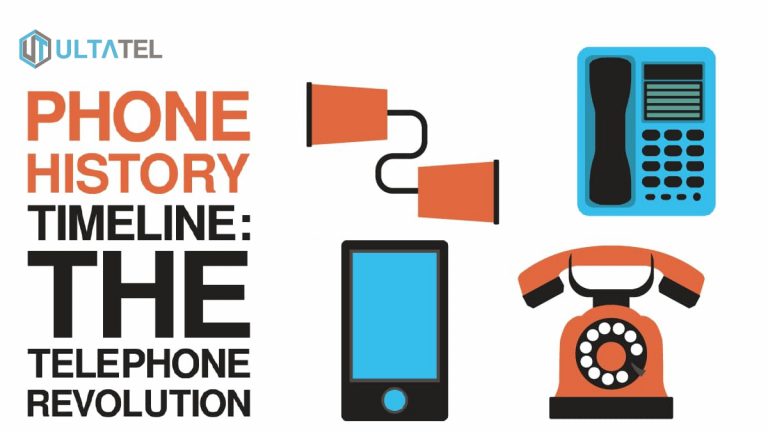In 1871, the era of telecommunication started the telephone timeline history and has made a big impact up to this day. It’s considered to be one of the most phenomenal technological changes of all time.
It started with a dream that many have tried to achieve but only few succeeded. Fast forward to today, communication has become essential for maintaining connections across the world. People need not to be near one another to strike a conversation.
Communicating over the phone brings us together and helps us to feel the comfort of our loved ones even from afar. It allows us to give quick updates regardless of the distance.
Nowadays, phone technology is fundamental in businesses. It plays an important role in every business transaction. To know the complete evolution of the telephone timeline, read more below.

1870s – 1910s: The Telephone Was Invented
In 1876, Alexander Graham Bell invented the telephone and made the first phone call. A year later, there were 3000 active users in record. Then in 1881, the first long-distance phone service started. They also provided the yellow pages directory.
Telephones went mainstream in the early 20th century. They installed the first coin-operated telephone and the first manual switchboard debuted in 1878. It led to the first “official” transcontinental phone call in 1915. Bell from New York City phoned Thomas A. Watson in San Francisco.
1920s – 1940s: Hoover and His Office Telephone
Herbert Hoover was the first U.S. president that used a phone in his office to talk from outside a booth. And in 1946, Bell’s company hired 250,000 women as Switchboard Operators for public and business services.
1950s – 1960s: Global Communication Became More Convenient
Bell’s company decided to lay down the first transatlantic phone cable that made global communication more convenient. Calls were automatically routed to different extensions without manual switching.
In this era, the first Touch-Tone phone with a lighted dial became part of American pop culture and was marketed to traveling business people.
Then in 1964, at the New York World’s Fair, the first video conferencing feature appeared in the timeline of telephone – called the Picturephone. Hotlines were established and 911 was chosen as the nationwide emergency number.
1970s – 1980s: The Era of Mobile Phones
This is considered the era of portable mobile phones – cell phones.
Martin Cooper, a senior engineer in Motorola, introduced the first-ever mobile phone in the world. It was the Motorola DynaTAC 8000X at a premium cost of $4000 USD. The prototype handset weighed 2.5 pounds, and it offered 30 minutes of talk-time, six hours standby, and can store up to 30 contact numbers.
1990s: The Internet Era and VoIP
This was considered the internet era.
They introduced a new feature which is the caller ID and it became a controversial subject in America during this time. Also, mobile phones were no longer restricted to business use but were open to mass production.
And in 1995, VocalTec patented the first internet call – Voice over Internet Protocol (VoIP), also called IP telephony. They introduced a peripheral device in the international market that can provide voice calling for desk computers.
Nokia took advantage of this transition and launched a handset in telephone timeline history with picture display. It was the Nokia 1011 and it offered mobile calling, SMS, and games. Since then, Americans got their internet connection through their mobile phones.
To learn more about VoIP and its advantages over traditional phones, read this article.
2000 and Beyond: The Release of the First Blackberry Handset
The first Blackberry handset with cell phone service was released. It offered real ringtone, Wi-Fi, Quad-band, and full web browsing in Opera Mini. This device can be used anywhere across the globe.
The applications for computers and smartphones were also developed into full integration of landlines, softphones, and VoIP was hosted in Private Branch Exchange (PBX) phone systems. It allowed users to surf the Internet, check their email, make phone calls, and check voicemail from a single device.
A few years later, the iPhone debuted and most lines became VoIP-based. It helped us to communicate through voice calls or conference calls instantly across the globe at an affordable rate.
Mobile phones are getting smarter too. It provided a capacitive touchscreen feature and replaced the traditional buttons to swiping and scrolling. This evolution made a widespread and inexpensive tool for communication.
Final Words
Smartphones have become essential to our modern life. As you can see, the way we communicate continually changes from time to time. Now we get to enjoy more features and flexibility, making modern devices essential to everyday life.
Phones bring loved ones from around the world together, make business transactions smoother, provide entertainment, and allow users to capture every moment. We hope you’ve learned from today’s topic on the phone history timeline!
Telephone systems, like many other technologies, have evolved over the past century and VoIP phone systems now include many advanced features that make communication simpler, more reliable, more efficient, and more affordable. In fact, advanced VoIP systems are invaluable tools for any business.
If you’re looking for a robust and reliable communications solution for your business, get in touch with ULTATEL. Our cloud-based phone systems offer everything you need to change the way you and your customers communicate.

